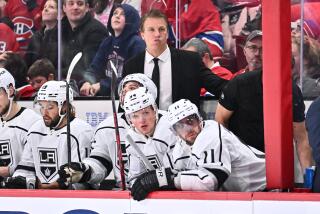Making His Mark : Flyers’ Tough Lindros Prefers Messier as Model for NHL Superstardom
- Share via
PHILADELPHIA — Before Mark Messier had a Stanley Cup ring for every finger of his shooting hand and one left over, he was a teen-age sensation on a brash, young team.
Before he added a new dimension to the center position by combining brute strength with fierce determination, he had to learn through defeat what it takes to win.
Fifteen years later, Eric Lindros of the Philadelphia Flyers is all that Messier once was. Having defeated Messier’s New York Rangers in the Eastern Conference semifinals last week, Lindros is well on his way to proving he is Messier’s equal--and that he may someday be superior.
At 22 and with three impressive seasons behind him, Lindros is considered the heir to the aging Wayne Gretzky and ailing Mario Lemieux as the NHL’s torchbearer. But the better comparison is between Lindros and Messier.
Neither made the playoffs in his first professional season. Messier made his breakthrough in 1981-82, his third season, when he earned his first all-star designation and scored 88 points. This season, Lindros’ third, he tied Jaromir Jagr of the Pittsburgh Penguins for the scoring lead with 70 points over the lockout-shortened schedule. He lost the title because Jagr had 32 goals to his 29 and might have won if not for an eye injury that idled him the last two games of the season.
Just as Messier contributed so much to the five Stanley Cups won by the Edmonton Oilers between 1984 and 1990, Lindros this season led the Flyers to the playoffs for the first time in six years. He applied a final flourish to their first-round rout of Buffalo when he returned from that eye injury and dazzled the Sabres by going on a five-point spree in the last two games. Buffalo Coach John Muckler was compelled to call a timeout in the series finale to scold his players, “Don’t stand around watching Eric play.”
The Sabres’ reaction didn’t surprise Lindros’ teammates. “He does so many great things on the ice, some players can get caught watching him,” left wing John LeClair said. “It’s scary to think of, but I think he can get better. He’s a great player now but he can get better.”
Lindros, LeClair and right wing Mikael Renberg--nicknamed “The Legion of Doom” for their size and effectiveness--outplayed the line of Messier, Adam Graves and Pat Verbeek in sweeping the defending Stanley Cup champion Rangers. Lindros’ line had a combined plus-minus rating of plus 12, to the Messier line’s minus 21. Messier outscored Lindros, collecting a goal and four assists to a goal and three assists for Lindros, but the Flyer trio produced eight goals and 21 points and Messier’s line had three goals and 11 points.
The Flyers will face the New Jersey Devils in the conference finals, starting Saturday at Philadelphia.
For Lindros, who used to carry Messier’s hockey card in his wallet, the sweep was stunning. “To be honest, I never thought it would happen this quickly,” he said. “I have a lot of respect for that team.”
Lindros’ 6-foot-4, 229-pound frame alone would be enough to earn opponents’ respect. But he also possesses a lust for hitting, a clever touch with the puck and the rare ability to grab control of a game.
“He’s unique. He brings it all to the league on a grander scale than anybody else,” said Flyer center Craig MacTavish, who played with Messier in Edmonton and in New York last year. “He’s just bigger, he’s stronger, he’s faster--he’s the new, improved NHL prototype.
“Eric, in all likelihood, is going to win the Hart Trophy as the most valuable player, and he brings a lot of the same things to the rink that Mark Messier [a two-time MVP] has brought to his teams over the years. Eric is big, he’s strong, he’s vocal, and he’s a great leader. Above all, they both let their actions speak louder than words when they play the game.”
So far, the playoffs have been everything Lindros dreamed they’d be. And he has been everything the Flyers hoped he might be when they acquired him from the Nordiques in exchange for six players, two first-round draft picks and a pile of cash in 1992, after he was drafted by Quebec but refused to play there. The Rangers also tried to acquire him, but an NHL-appointed arbitrator ruled the deal between the Flyers and Nordiques was valid.
“It’s been a lot of fun,” Lindros said of his postseason experience. “There have been a couple of periods where we really played some good hockey, when we’ve played with authority. The team has really played well and we’ve gotten great goaltending all the way through. We’re learning as we go, and we’re hoping we can get better.”
He never chose to be a leader. “It’s just something that has happened,” he said. “My game has improved, and we’re getting better as a team. It’s definitely a feeling of knowing we’re achieving something but also a feeling that we can achieve much more. . . .
“I really thought we bottomed out my first couple of years. We really didn’t have much going. We’d won a few games in a row and then we’d slide and we just couldn’t stop the slide. We couldn’t stop at one or two in a row--we’d lose eight in a row. Now, we feel any night we step on the ice we have a chance to win and in the back of our minds, we’re pretty confident we will.”
That confidence stems from LeClair’s acquisition from Montreal in early February. Before the brawny but slow-skating LeClair came to Philadelphia, he had one goal, Lindros had four goals and Renberg had one. Together, they collected 74 goals (25 each for Lindros and LeClair and 24 for Renberg) and 159 points as the Flyers won the Atlantic Division title.
“Anybody [Flyer General Manager] Bob Clarke brings here or grabs in a trade, you know is going to be a great thing,” Lindros said. “We just seemed to click. It seemed to work out pretty well.”
Pretty well? Muckler called them awesome, and he wasn’t exaggerating.
“When Johnny came, he and Eric took us up to a higher level,” Renberg said. “We just started playing great right away. I didn’t know we’d play that good. After two or three games we really started to fit together.”
Clarke saw in LeClair “a big guy who could skate. We didn’t know his hands were as good as they are, but we had Lindros for him to play with. He can go into the corner and get the puck, he can hang onto it down low and set picks and he can get clear in front of the net. . . . He’s a good player, and he can be a great player on Lindros’ line.”
That’s another trait Lindros shares with Messier: the ability to make his teammates better through his skill and his will.
“He’s looking forward to playing every game, to practicing, to taking the responsibility on his shoulders and going out and doing something about it,” said Flyer assistant coach Tom Webster, a former King coach. “Whether that’s maturity or the team you’re playing on or the environment you’re in, all those things you see in that kind of player, we’re seeing inhim.
“You look for certain things that are indicators. You look at how a player plays in important games. You see the sparkle in his eye and you see a take-charge attitude few people have. The great ones have it.”
Lindros ranks Messier in that category. “I don’t think there’s anybody who ever played the game who is as great a talent and competitor as Mark Messier,” Lindros said.
Said Clarke: “He can’t be Mark Messier yet, but he will be someday. He’s got to experience things that made Mark Messier what Messier is. Through experiencing them, he’s going to be a great captain.”
More to Read
Go beyond the scoreboard
Get the latest on L.A.'s teams in the daily Sports Report newsletter.
You may occasionally receive promotional content from the Los Angeles Times.







